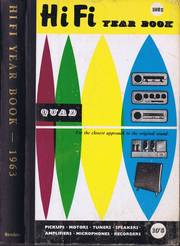In einem Buch aus 1962 haben wir es gefunden
Wie denken die Engländer im Jahr 1962 über die Meilensteine der Audio-Technik ? Von den Amerikanern (also in einem Buch aus Amerika) haben wir gelesen, daß fast alle markanten Erfindungen in den USA stattfanden, vor allem, das Magentbandgerät wurde von AMPEX erfunden usw....... In dem ganzen amerikanischen Buch kommt der Begriff "Europa" nur am Rande vor, das sei eine Insel draußen vor Neupfundland. Nun ja .....
Diese englische Auflistung sieht also recht neutral und ausgewogen aus.
Natürlich sehen Engländer die Audio-, Tonband- und Hifi Welt aus ihrer Sicht (dem Kernland des Empire) etwas anders als wir hier in Deutschland West. Denn auch bei uns ist immer noch nicht alles aus den verdammten 12 Jahren korrekt aufgearbeitet, zum Bespiel die Legenden um den alten Paul Nipkow, der ja das Fernsehen erfunden haben soll, laut NS Propaganda im Dritten Reich - sowie die Legenden um Walter Bruch, der ja das Farbfernsehen erfunden haben soll. Im Fernsehmuseum können Sie lesen, was es damit wirklich auf sich hatte.
.
A record of audio landmarks
Aus dem Hifi-Jahrbook 1962 (Ausgabe 1963) zusammengestellt von Peter Ford, 1962
bis 1899
.
- 1876 The telephone invented independently by Bell and Gray (USA).
- 1877 Mechanical sound recording and reproduction envisaged by Cros (France) and achieved independently by Edison (USA).
Carbon microphone invented by Berliner (USA) - competing models devised by Edison (USA), Blake, Hunnings (England) and others.
Moving-coil microphone invented independently by Siemens (Germany) and Cuttriss and Redding (USA). - 1878 Capacitor (electrostatic) microphone and telephone receiver invented by Edison (USA).
- 1879 Selenium devices for speech transmission investigated by Bell (USA).
- 1881 Wax cylinder and disk recordings by Tainter (England) and C. Bell in Washington D.C.
Binaural telephone transmissions from Paris Opera by Ader (France). - 1884 Constant linear speed disk record devised by Tainter in Washington D.C.
- 1887 Wax cylinder dictating machine (Graphophone) marketed (USA).
Berliner (USA) announces invention of the Gramophone. - 1888 Zinc-etching recording process for the Gramophone devised by Berliner.
Edison produces improved wax cylinder recording machine. - 1889 Stressed aluminium diaphragm invented in USA by Bettini (Italy).
- 1890 Introduction of wax cylinder records for public entertainment at sideshows (USA).
First - toy - gramophone records and gramophones manufactured (Germany). - 1893 Lioret (France) produces moulded celluloid cylinder records.
First manufacture of gramophones in USA. - 1894 Production of cylinder records for home entertainment commenced in USA.
- 1897 The spring-driven gramophone. Shellac compound first used in record manufacture.
First cheap cylinder phonographs marketed - as reproducers only. - 1898 Poulsen (Denmark) invents magnetic wire recorder: the Telegraphone.
Lodge (England) devises moving-coil loudspeaker. - 1899 Johnson (USA) introduces wax cutting in gramophone recording.
Stroh (England) invents the Stroh violin for use in recording studios.
.
von 1901 bis 1934
.
- 1901 First 10-inch gramophone records.
Moulded cylinder records perfected. - 1902 Poulsen and Pedersen invent DC bias method of reducing distortion in magnetic recording (Denmark).
Duddell (England) invents photographic method of sound recording. - 1903 First 12-inch gramophone records.
Improved magnetic wire recorders adopted by General Post Office, London.
Parsons (England) demonstrates Auxetophone - practical method of using compressed air amplification. - 1904 First double-sided gramophone records (Germany).
Fleming (England) invents diode valve.
First attempt at marketing long-playing record (England). - 1906 de Forest (USA) invents triode valve and single-stage audio amplifier. (Hier fehlt die LIEBEN Röhre)
- 1907 Lauste (France) invents method of recording sound with picture, on film, in England.
- 1908 Four-minute cylinder records (USA).
- 1912 Cylinder records moulded in plastics (USA), de Forest (USA) invents multi-stage amplifier using triodes in cascade.
Satisfactory commercial model wire recorder at last produced in USA. - 1915 Colpitts (USA) devises push-pull output circuit.
- 1917 Wente (USA) devises high quality capacitor microphone for acoustic measurements.
Langevin (France) devises means of using piezo-electric transducers in underwater signalling. - 1919 First experimental work on high quality electrical disk recording:
Guest and Merriman (England),
Sykes (England), Frederick and Harrison (USA).
First experiments on high quality photographic sound-on-film recording: Vogt, Engel and Massolle (Germany). - 1921 Carlson and Carpenter (USA) invent AC bias method of reducing distortion in magnetic recording.
Experimental binaural broadcasts by Doolittle (USA).
Emerson (USA) proposes disk records with two recordings in a single groove. - 1922 Semi-automatic record presses introduced.
Hull invents indirectly-heated cathode valve.
Pemberton-Billing introduces constant linear speed disk record (England).
Stille (Germany) begins development of magnetic recording equipment for entertainment purposes.
Daily broadcasting commenced by British Broadcasting Company: London, Newcastle, Birmingham and Manchester transmitters. - 1923 Quiet-surface laminated shellac records introduced in England.
High quality electrical disk recording system in advanced state of development in USA.
Frederick (USA) invents "infinite baffle,, loudspeaker enclosure.
Many designs of moving-iron loudspeaker.
Case (USA) invents Aeolight modulator - later basis of "Movietone" sound-film system. - 1924 Major record manufacturers take licences to use high quality disk recording system.
Seymour and Ginn (England) devise high quality handmade gramophones.
Wilson (England) calculates and publishes tone arm tracking error formulae.
Riegger (Germany), Round and Voigt (England) work on direct radiator moving-coil loudspeakers. - 1925 First commercial electrical recordings by major manufacturers.
Reisz (Hungary) invents diaphragmless transverse-current carbon microphone.
Russell and Cotton (England) demonstrate piezo-electric crystal pick-up.
The Rice-Kellog loudspeaker (USA).
Weil (USA) devises corner speaker mounting.
Minton and Ringel (USA) devise tweeter-woofer speaker combination.
First commercial sound-films "Vitaphone" made in New York. - 1926 Voigt (England) uses moving-coil disk cutter commercially.
Vogt (Germany) develops small electrostatic full range loudspeaker. - 1927 Preuss and Francis (England) devise variable-pitch disk recording method.
Kellog (USA) devised balanced armature moving-iron pickup.
High (USA) invents labyrinth loudspeaker enclosure.
First commercial sound-on-film talking pictures.
Pfleumer (Germany) and O'Neill (USA) devise coated tapes for magnetic recording. - 1928 Pentode output valve invented (Holland).
Bimorph construction for piezo-electric transducers invented by Sawyer (USA).
Perforated steel tape magnetic recorder for sound-film use produced by Stille (Germany).
Improved variable-density and variable-area sound-film recording equipment produced in USA and Germany.
Round (England) produces electrically recorded microgroove long-playing records. - 1929 Improved capacitor microphones introduced in USA and elsewhere.
High quality moving-coil microphone and disk recording equipment designed by Blümlein, Holman and others (England).
Needle-armature moving-iron pickups introduced. - 1930 Thuras (USA) invents phase-inverter method of loading microphone and loudspeaker diaphragms.
First experiments with extended vinyl materials for record manufacture (USA).
BBC adopts magnetic steel tape recording. - 1931 Olson (USA) invents limp strip ribbon microphone.
Blümlein (England) works on coincident microphone stereophonic recording system.
Frederick and Harrison (USA) devise high quality vertical-cut recording system for broadcast use.
Development of "Magneto-phon" plastic tape magnetic recording system commenced (Germany). - 1932 Neumann (Germany) introduces improved capacitor microphone with gold-plated collodion diaphragm.
Olson and Weinberger (USA) devise ribbon microphone with rear loading.
Further attempts to market long-playing records in England and USA. - 1933 Experimental complex-cut stereo disk records made in England.
Experimental wire transmission of three-channel stereo in USA. - 1934 Armstrong (USA) devises FM interference-free radio system.
Direct recording blanks developed by Watts (England) and in France and Germany.
Watts' equipment adopted by BBC.
Alexander (England) designs standard BBC ribbon microphone.
Black (USA) publishes details of negative feedback circuitry and principles.
Voigt (England) devises quarter-wave loading principle for loudspeakers.
First production of cellulose acetate based coated magnetic tape (Germany).
Improved design of steel tape recorder adopted by BBC.
.
von 1934 bis 1944
.
- 1935 The "Magnetophon" tape recorder publicly demonstrated (Germany).
High quality 25-gram pickup with sapphire stylus and oil-damped moving-iron cutting head with range to 10 kc/s designed (Germany).
Spherical case moving coil microphone designed (USA).
Directional (cardioid) capacitor microphone invented by Braunmiihl and Weber (Germany).
Sound recording committee of St. Dunstan's and N.I.B. ("talking books for the blind") established (England).
Wide screen film with stereophonic sound demonstrated (England). - 1936 Ultra-violet light recording introduced for sound-films.
Experimental complex-cut stereo disks in USA.
British Sound Recording Association founded.
High-definition television service opened by BBC. - 1937 Noise-cancelling lip microphone adopted by BBC for outside broadcast work.
Lightweight British moving-iron pickup designed.
Triode-tetrode ("ultra-linear") output circuit devised by Blümlein (England). - 1938 Negative feedback successfully applied in disk recording head (USA).
High quality studio "Magnetophon" tape recorder introduction in broadcasting (Germany). - 1939 Voigt moving-coil pickup designed (England)
Development of stereophonic and multichannel sound films commenced in USA.
Further development of magnetic wire recorders commenced (USA). - 1941 Braunmuhl and Weber apply AC bias to "Magnetophon" sound recording system (Germany).
Intensive development of magnetic wire recording by Camras and others (USA).
Klipsch (USA) produces improved folded-horn loudspeaker enclosure. - 1942 Intensive development of extended range disk recording by British record companies to meet needs of armed forces.
National Association of Broadcasters (USA) adopts disk recording standards.
First experimental stereophonic tape recordings (Germany). - 1944 Commercial introduction of extended range gramophone records by British manufacturers.
Improved "Magnetophon" equipment produced in Germany with PVC based coated tape.
.
von 1945 bis 1962
.
- 1945 Miniature armature extended range gramophone pickups produced in Britain.
First amplifier with 0.1 % distortion designed and produced in Britain.
Vinyl based gramophone records made and sold in USA. - 1946 Carrier-stereophony disk recording system designed in England.
- 1947 Improved disk recording heads - feedback moving-coil - produced in USA and Denmark.
Magnetophon-type tape recording equipment and coated tapes widely adopted outside Germany. - 1948 Long-playing 30cm - 33 1/3 rpm records introduced (USA).
Hot stylus disk cutting technique adopted.
Improved (acicular) type of oxide coating adopted for magnetic tape, facilitating reduction in tape speed.
Experimental work in England, USA and elsewhere on application of magnetic recording to sound-film systems.
Invention of transistor announced (USA). - 1949 45 rpm records introduced (USA).
78 rpm records with extended playing time introduced (Germany).
Improved crystal pickups marketed (England). - 1951 Experiments in microgroove stereo disk recording commenced in England.
Very lightweight FM pickup (1 gram tracking) marketed (USA).
Recorded tapes for home entertainment released in USA. - 1952 Improved variable directivity capacitor microphones introduced (Germany).
Modern type noise-cancelling lip microphone introduced in Britain.
First multi-channel sound-films commercially released. - 1953 Research on modern types of capacitor (electrostatic) loudspeaker commenced in Britain and USA.
Introduction of modern miniature ribbon BBC microphone. - 1954 Recorded tapes (mono) released in Britain.
Tape cassette system developed for "talking books" (England).
Experiments with complex-cut stereo disks in USA and carrier stereo lateral cut disks in England.
First commercial recording sessions using stereo tape equipment by record companies. - 1955 Stereo tape records marketed in Britain.
Appearance of commercial electrostatic loudspeakers.
BBC VHF transmitters at Wrotham, Kent, opened. - 1956 First high quality stereo disk cutting equipment in advanced state of development.
Experimental stereo disks demonstrated in London. - 1957 European and US record manufacturers agree on stereo disk standards.
First commercial stereo disks released in USA.
Moving magnet pickups developed (Holland and USA). - 1958 General introduction of stereo disks.
First experimental stereo broadcasting by BBC.
Compatible stereo record proposed by Goldmark (USA) but not adopted.
Tape cassette four-track stereo equipment introduced in USA.
Thinner based "double play" tape marketed. - 1961 G. E.-Zenith system for stereo broadcasting is officially approved by the FCC and adopted by USA.
- 1962 Development of fully tranistorized high power audio amplifiers.
BBC commences experimental transmissions using G. E.-Zenith stereo system.
Acknowledgement: Some data concerning the BBC have been checked by reference to the BBC Handbook, 1963 edition.
.


